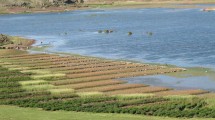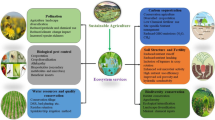Abstract
Pecans are native to a number of states in southern and midwestern United States and to scattered locations in Mexico, but are most common in Texas, Oklahoma, and Louisiana. They have been growing over their present range in the U. S. for at least 8000 years and, based on archaeological and ethnohistoric data, were an important source of food for people who inhabited certain areas within this range in prehistoric and early historic times. In addition to being fixed in space and highly productive, pecan groves produce a food that requires little processing to be suitable for human consumption. However, the groves have strong biennial production cycles so that yield in a given region can vary dramatically from year to year. The groves comprising the greatest concentrations of pecans in the U. S. may have influenced the formation of prehistoric territories and thus affected interregional exchange through reciprocal resource-sharing alliances.
Résumé
Elnogal pecanero o nuez pecanera es producto de un arbol originario de algunos estados del sur y del medioeste de los Estados Unidos. También se encuentra en algunas localidades mexicanas. La mayor concentración de arboledas de tipo nativo se encuentra en los estados de Texas, Oklahoma, y Louisiana. El nogal pecanero ha existido adonde hoy se encuentra por lo menos por unos 8000 anos. Basandose en datos arqueológicos y etnohistóricos, constituia un alimento humano de importancia en tiempos prehistóricos y a comienzos del período histórico. El nogal pecanero provee un recurso productivo y de ubicación constante y conocida. Además, las nueces se pueden comer sin mucho procesamiento. Los arboles tienen un ciclo de dos años, asi que la produccion de cualquier region especifica no es constante. Se propone que las regiones de mayor concentracion de nogal pecanero hayan tenido una influencia importante en la formation de los territorios prehistoricos. También se propone que estas regiones hayan sido importantes en el intercambio regional, a través de sistemas de reciprocidad in compartir los recursos naturales.
Similar content being viewed by others
Literature Cited
Asch, N. B., R. I. Ford, and D. L. Asch. 1972. Paleoethnobotany of the Koster Site: The Archaic Horizons. Reports of Investigations No. 24, Illinois State Museum, Springfield, Illinois.
Banfleld, A. W. F. 1974. The mammals of Canada. University of Toronto Press, Toronto, Canada.
Bettis, E. A., III, R. G. Baker, B. K. Nations, and D. W. Benn. 1990. Early Holocene Pecan,Carya illinoensis, in the Mississippi River Valley near Muscatine, Iowa. Quaternary Research 33:102–107.
Bourne, E. G., ed. 1904. Narratives of the career of Hernando de Soto, Volume I. Translated by Buckingham Smith. A. S. Barnes and Company. New York.
Brain, J. P. 1985. Introduction: Update of De Soto Studies Since the United States De Soto Expedition Commission Report. Pages xi-xxxiiin J. R. Swanton, ed., Final Report of the United States De Soto Expedition Commission (reprinted in Classics of Smithsonian Anthropology. Smithsonian Institution Press. Washington, D. C. Originally published 1939).
Brison, F. R. 1974. Pecan Culture. Capital Printing. Austin, Texas.
Brown, K. 1995. Nut hulls aren’t nutshells! (or, pericarping about terminology). Newsletter—Council of Texas Archeologists 19(l):5–8. Texas Archeological Research Lab. The University of Texas at Austin.
Caire, T. W., J. D. Tyler, B. P. Glass, and M. A. Mares. 1989. Mammals of Oklahoma. University of Oklahoma Press, Norman.
Campbell, T. N. 1975. The Payaya indians of southern Texas. Special Publication 1, Southern Texas Archaeological Association. San Antonio, Texas.
—,and T. J. Campbell. 1981. Historic indian groups of the Choke Canyon Reservoir and surrounding area, southern Texas. Choke Canyon Series: Vol. 1, Center for Archaeological Research, The University of Texas at San Antonio. San Antonio, Texas.
Chadderdon, M. F 1983. Baker Cave, Val Verde County, Texas: the 1976 excavations. Special Report 13, Center for Archaeological Research, The University of Texas at San Antonio. San Antonio, Texas.
Covey, Cyclone, (translator). 1961. Adventures in the unknown interior of America. University of New Mexico Press. Albuquerque, New Mexico.
Duke, J. A. 1989. CRC Handbook of nuts. CRC Press. Boca Raton, Florida.
Emerson, A. M. 1990. Archaeological implications of variability in the economic anatomy ofBison bison. Ph.D. dissertation. Washington State University, Pullman.
Geiser, S. W. 1945. Horticulture and horticulturalists in early Texas. University Press in Dallas. Dallas, Texas.
Hackett, C. W., ed. 1931. Pichardo’s Treatise on the Limits of Louisiana and Texas, Vol. I. University of Texas Press. Austin, Texas.
Hall, G. D. 1995. Prehistoric cemeteries on the Texas central coastal plain: interpretations and hypotheses. Pages 633–647in A. J. Taylor and C. L. Highley, Archeological investigations at the Loma Sandia site (41 LK 28): a prehistoric cemetery and campsite in Live Oak County, Texas. Studies in Archeology 20. Texas Archeological Research Laboratory. The University of Texas at Austin.
—. 1998. Prehistoric human food resource patches on the Texas coastal plain. Bulletin of the Texas Archeological Society 69:1–10.
Hatcher, M. A. (translator). 1928. Descriptions of the Tejas or Asinai Indians, 1691-1722. The Southwestern Historical Quarterly Volume XXXI. July, 1927 to April, 1928. The Texas State Historical Association. Austin.
Hester, T. R. 1978. Early human occupations in south central and southwestern Texas: preliminary papers on the Baker Cave and St. Mary’s Hall sites. Center for Archaeological Research, The University of Texas at San Antonio. San Antonio, Texas.
Hodge, F. W. ed. 1912. Handbook of American indians north of Mexico, Part 2. Smithsonian Institution, Bureau of American Ethnology Bulletin 30. Washington D.C.
Jackson, H. E. 1989. Poverty point adaptive systems in the Lower Mississippi Valley: subsistence remains from the J. W. Copes site. North American Archaeologist 10(3): 173–204.
Kelley, J. C. 1955. Juan Sabeata and diffusion in aboriginal Texas. American Anthropologist 57(5): 981–995.
Little, E. L., Jr. 1971. Atlas of United States trees, Volume 1, conifers and important hardwoods. U. S. Department of Agriculture, Forest Service, Miscellaneous Publications 1146.
Menefee, S. C., and O. C. Cassmore. 1940. The pecan shellers of San Antonio—The problem of underpaid and unemployed Mexican labor. Federal Works Agency, Works Projects Administration, Division of Research. United States Government Printing Office. Washington, D. C.
Nuñez Cabeza de Vaca, Alvar. 1971. Naufragios y Comentarios. Qinta edicion. Espasa-Calpe, S.A. Madrid.
Read, W. A. 1963. Louisiana-French. Louisiana State University Press.
Santerre, C. R. 1994. Pecan processing, Pages 49-67,in C. R. Santerre, ed., Pecan technology. Chapman and Hall.
Smith, J. R. 1953. Tree crops. The Devin-Adair Company, New York.
Speth, J. D., and K. A. Speilmann. 1983. Energy source, protein metabolism, and hunter-gatherer subsistence strategies. Journal of Anthropological Archaeology 2(1): 1–31.
Stuckey, H. P., and E. J. Kyle. 1925. Pecan-growing. The Macmillan Company. New York.
Styles, B. W., S. R. Ahler, and M. L. Fowler. 1983. Modoc Rock shelter revisited. Pages 261–297in J. L. Phillips and J. S. Brown, eds., Archaic hunters and gatherers in the American Midwest. Academic Press. New York.
Talalay, L., D. R. Keller, and P. J. Munson. 1984. Hickory nuts, walnuts, butternuts, and hazelnuts observations and experiments relevant to their aboriginal exploitation in eastern North America. Pages 338–359in P. J. Munson, ed., Experiments and observations on aboriginal wild plant food utilization in eastern North America, Prehistory Research Series, Volume VI, Number 2. Indiana Historical Society. Indianapolis, Indiana.
Texas Department of Agriculture 1981. 1980 Texas fruit and pecan statistics. Texas Department of Agriculture and U. S. Department of Agriculture Bulletin 191. Austin, Texas.
-. 1983. 1982 Texas fruit and pecan statistics. Texas Department of Agriculture and U. S. Department of Agriculture Bulletin 209. Austin, Texas.
-. 1984. 1983 Texas fruit and pecan statistics. Texas Department of Agriculture and U. S. Department of Agriculture Bulletin 217. Austin, Texas.
-. 1986. 1985 Texas fruit and pecan statistics. Texas Department of Agriculture and U. S. Department of Agriculture Bulletin 234. Austin, Texas.
Thompson, T. E., and L. J. Grauke. 1991. Pecans and hickories(Carya). Acta Horticulturae Number 290-XVIII:839–904.
Tous, G. 1930. Ramon Expedition: Espinosa’s diary of 1716. Preliminary Studies of the Texas Catholic Historical Society 12(4).
True, R. H 1919. Notes on the early history of the pecan in America. Pages 435–438in Annual Report of the Board of Regents of the Smithsonian Institution Showing the Operations, Expenditures, and Condition of the Institution for the Year Ending June 30, 1917. U. S. Government Printing Office. Washington, D. C.
U. S. Department of Agriculture. 1936–1992. Agri cultural statistics. U. S. Government Printing Of fice. Washington, D. C.
—. 1943. A graphic summary of farm crops. Bureau of Agricultural Economics, Miscellaneous Publication No. 512. Washington, D. C.
U. S. Department of Commerce. 1981a. 1978 Census of Agriculture, Book 1, Volume 1 State and County Data, Part 43 Texas AC78-A-43. Bureau of the Census.
-. 1981b. 1978 Census of Agriculture, Volume 1 State and County Data, Part 36 Oklahoma AC78-A-36. Bureau of the Census.
-. 1981c. 1978 Census of Agriculture, Volume 1 State and County Data, Part 18 Louisiana AC78-A-18. Bureau of the Census.
Wolstenholme, B. N 1979. Pecan ecology. Pages 4–15in G. R. McEachern, ed., Texas pecan handbook. Compiled as the Proceedings of the 1982 Texas Pecan Short Course, Texas A&M University. Sponsored by the Texas Agricultural Experiment Station and the U. S. Department of Agriculture. College Station, Texas.
Wood, B. W. 1993. Production characteristics of the United States pecan industry. Journal of the Amer ican Society of Horticultural Science 118(4):538–545.
Author information
Authors and Affiliations
Rights and permissions
About this article
Cite this article
Hal, G.D. Pecan food potential in prehistoric North America. Econ Bot 54, 103–112 (2000). https://doi.org/10.1007/BF02866604
Received:
Accepted:
Issue Date:
DOI: https://doi.org/10.1007/BF02866604




